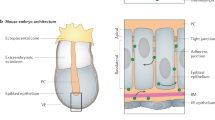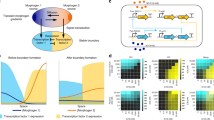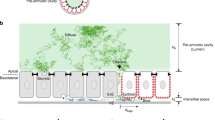Abstract
It is widely accepted that tissue differentiation and morphogenesis in multicellular organisms are regulated by tightly controlled concentration gradients of morphogens1,2. How exactly these gradients are formed, however, remains unclear3,4,5,6,7,8,9,10,11,12. Here we show that Fgf8 morphogen gradients in living zebrafish embryos are established and maintained by two essential factors: fast, free diffusion of single molecules away from the source through extracellular space, and a sink function of the receiving cells, regulated by receptor-mediated endocytosis. Evidence is provided by directly examining single molecules of Fgf8 in living tissue by fluorescence correlation spectroscopy, quantifying their local mobility and concentration with high precision. By changing the degree of uptake of Fgf8 into its target cells, we are able to alter the shape of the Fgf8 gradient. Our results demonstrate that a freely diffusing morphogen can set up concentration gradients in a complex multicellular tissue by a simple source-sink mechanism.
This is a preview of subscription content, access via your institution
Access options
Subscribe to this journal
Receive 51 print issues and online access
$199.00 per year
only $3.90 per issue
Buy this article
- Purchase on Springer Link
- Instant access to full article PDF
Prices may be subject to local taxes which are calculated during checkout




Similar content being viewed by others
References
Wolpert, L. Positional information and the spatial pattern of cellular differentiation. J. Theor. Biol. 25, 1–47 (1969)
Tabata, T. & Takei, Y. Morphogens, their identification and regulation. Development 131, 703–712 (2004)
Crick, F. Diffusion in embryogenesis. Nature 225, 420–422 (1970)
Kerszberg, M. & Wolpert, L. Mechanisms for positional signalling by morphogen transport: a theoretical study. J. Theor. Biol. 191, 103–114 (1998)
Entchev, E. V., Schwabedissen, A. & Gonzalez-Gaitan, M. Gradient formation of the TGF-β homolog Dpp. Cell 103, 981–992 (2000)
Strigini, M. & Cohen, S. M. Wingless gradient formation in the Drosophila wing. Curr. Biol. 10, 293–300 (2000)
McDowell, N., Gurdon, J. B. & Grainger, D. J. Formation of a functional morphogen gradient by a passive process in tissue from the early Xenopus embryo. Int. J. Dev. Biol. 45, 199–207 (2001)
Gregor, T., Bialek, W., de Ruyter van Steveninck, R. R., Tank, D. W. & Wieschaus, E. F. Diffusion and scaling during early embryonic pattern formation. Proc. Natl Acad. Sci. USA 102, 18403–18407 (2005)
Lander, A. D. Morpheus unbound: reimagining the morphogen gradient. Cell 128, 245–256 (2007)
Kicheva, A. et al. Kinetics of morphogen gradient formation. Science 315, 521–525 (2007)
Gregor, T., Wieschaus, E. F., McGregor, A. P., Bialek, W. & Tank, D. W. Stability and nuclear dynamics of the bicoid morphogen gradient. Cell 130, 141–152 (2007)
Boldajipour, B. et al. Control of chemokine-guided cell migration by ligand sequestration. Cell 132, 463–473 (2008)
Reifers, F. et al. Fgf8 is mutated in zebrafish acerebellar (ace) mutants and is required for maintenance of midbrain-hindbrain boundary development and somitogenesis. Development 125, 2381–2395 (1998)
Reifers, F., Walsh, E. C., Leger, S., Stainier, D. Y. & Brand, M. Induction and differentiation of the zebrafish heart requires fibroblast growth factor 8 (fgf8/acerebellar). Development 127, 225–235 (2000)
Goldfarb, M. Functions of fibroblast growth factors in vertebrate development. Cytokine Growth Factor Rev. 7, 311–325 (1996)
Fürthauer, M., Reifers, F., Brand, M., Thisse, B. & Thisse, C. Sprouty4 acts in vivo as a feedback-induced antagonist of FGF signalling in zebrafish. Development 128, 2175–2186 (2001)
Raible, F. & Brand, M. Tight transcriptional control of the ETS domain factors Erm and Pea3 by Fgf signalling during early zebrafish nervous system development. Mech. Dev. 107, 105–117 (2001)
Scholpp, S. & Brand, M. Endocytosis controls spreading and effective signalling range of Fgf8 protein. Curr. Biol. 14, 1834–1841 (2004)
Rigler, R., Mets, Ü., Widengren, J. & Kask, P. Fluorescence correlation spectroscopy with high count rate and low-background: analysis of translational diffusion. Eur. Biophys. J. 22, 169–175 (1993)
Bacia, K., Kim, S. A. & Schwille, P. Fluorescence cross-correlation spectroscopy in living cells. Nature Methods 3, 83–89 (2006)
Amaya, E., Musci, T. J. & Kirschner, M. W. Expression of a dominant negative mutant of the FGF receptor disrupts mesoderm formation in Xenopus embryos. Cell 66, 257–270 (1991)
Ries, J., Yu, S. R., Burkhardt, M., Brand, M. & Schwille, P. Modular scanning FCS quantifies receptor-ligand interactions in living multicellular organisms. Nature Methods 10.1038/nmeth.1355 (2 August 2009)
Petrášek, Z. & Schwille, P. Precise measurement of diffusion coefficients using scanning fluorescence correlation spectroscopy. Biophys. J. 94, 1437–1448 (2008)
Brinkmeier, M., Dörre, K., Stephan, J. & Eigen, M. Two beam cross-correlation: a method to characterize transport phenomena in micrometer-sized structures. Anal. Chem. 71, 609–616 (1999)
Dertinger, T. et al. Two-focus fluorescence correlation spectroscopy: a new tool for accurate and absolute diffusion measurements. ChemPhysChem 8, 433–443 (2007)
Hou, S., Maccarana, M., Min, T. H., Strate, I. & Pera, E. M. The secreted serine protease xHtrA1 stimulates long-range FGF signalling in the early Xenopus embryo. Dev. Cell 13, 226–241 (2007)
Baeg, G. H., Selva, E. M., Goodman, R. M., Dasgupta, R. & Perrimon, N. The Wingless morphogen gradient is established by the cooperative action of Frizzled and Heparan Sulphate Proteoglycan receptors. Dev. Biol. 276, 89–100 (2004)
Desai, U. R., Wang, H. & Linhardt, R. J. Substrate specificity of the heparin lyases from Flavobacterium heparinum . Arch. Biochem. Biophys. 306, 461–468 (1993)
Robinson, M. S., Watts, C. & Zerial, M. Membrane dynamics in endocytosis. Cell 84, 13–21 (1996)
Westerfield, M. The Zebrafish Book; a Guide for the Laboratory use of Zebrafish (Danio Rerio) (Univ. of Oregon Press, 2000)
Petrov, E. P., Ohrt, T., Winkler, R. G. & Schwille, P. Diffusion and segmental dynamics of double-stranded DNA. Phys. Rev. Lett. 97, 258101 (2006)
Burkhardt, M. & Schwille, P. Electron multiplying CCD based detection for spatially resolved fluorescence correlation spectroscopy. Opt. Express 14, 5013–5020 (2006)
Acknowledgements
We thank members of the Brand and Schwille laboratories for discussions; A. Picker and K. Heinze for help with initial FCS measurements; B. Lutz for discussions; A. Oates, C. Boekel, A. Picker and P. Scott for comments on the manuscript; M. Fischer and K. Sipple for fish care; and A. Machate and B. Borgonov for technical assistance. This work was supported by an HFSP network grant (050503-50) to M.Br. and P.S., and by the EU Endotrack grant (050503-52) to M.Br.
Author Contributions S.R.Y. and M.Bu. performed the experiments, analysed the data and wrote the paper. M.N., J.R. and Z.P. provided advice on experimental design, data evaluation and interpretation. S.S. provided protocols for initial FCS measurements. P.S. and M.Br. initiated and supervised the collaboration, designed the project, analysed the data and wrote the paper.
Author information
Authors and Affiliations
Corresponding authors
Supplementary information
Supplementary Information
This file contains Supplementary Notes 1-8, Supplementary References and Supplementary Figures 1-10 with Legends. (PDF 1094 kb)
Rights and permissions
About this article
Cite this article
Yu, S., Burkhardt, M., Nowak, M. et al. Fgf8 morphogen gradient forms by a source-sink mechanism with freely diffusing molecules. Nature 461, 533–536 (2009). https://doi.org/10.1038/nature08391
Received:
Accepted:
Published:
Issue Date:
DOI: https://doi.org/10.1038/nature08391
This article is cited by
-
Gradient to sectioning CUBE workflow for the generation and imaging of organoids with localized differentiation
Communications Biology (2023)
-
Early radial positional information in the cochlea is optimized by a precise linear BMP gradient and enhanced by SOX2
Scientific Reports (2023)
-
Current capabilities and future perspectives of FCS: super-resolution microscopy, machine learning, and in vivo applications
Communications Biology (2023)
-
Fgf8 dynamics and critical slowing down may account for the temperature independence of somitogenesis
Communications Biology (2022)
-
Precision of morphogen gradients in neural tube development
Nature Communications (2022)
Comments
By submitting a comment you agree to abide by our Terms and Community Guidelines. If you find something abusive or that does not comply with our terms or guidelines please flag it as inappropriate.



